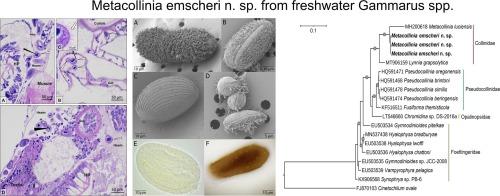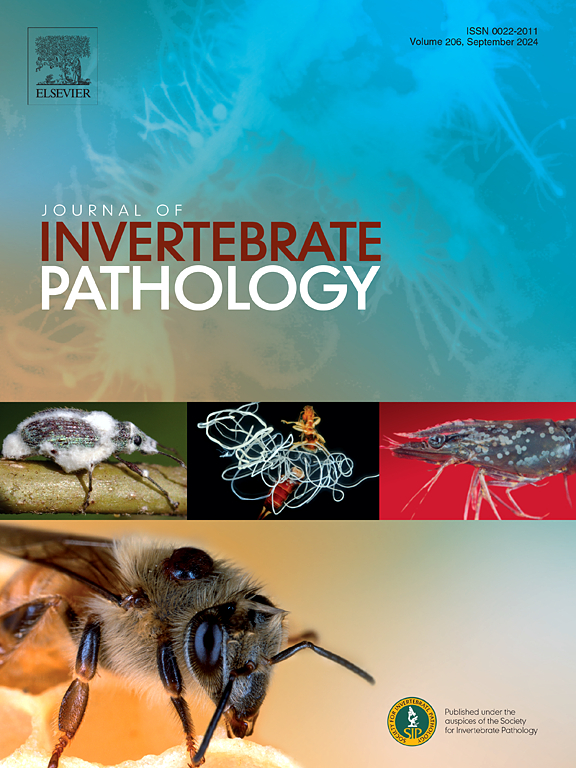Metacollinia emscheri n. sp., a novel sanguicolous apostome ciliate of freshwater amphipods (Gammarus spp.)
IF 3.6
3区 生物学
Q1 ZOOLOGY
引用次数: 0
Abstract
We describe a novel sanguicolous parasitic ciliate, Metacollinia emscheri n. sp., found in the freshwater amphipods Gammarus pulex and G. fossarum. This ciliate infected 8.05 % of the amphipods collected in a German stream catchment, the Boye, a tributary of the river Emscher. The ciliate showed morphological characteristics fitting the genus Metacollinia. Different life stages of variable size occurred simultaneously in the hemocoel throughout the hosts’ body. The tomont had 40–47 slightly spiraled kineties, a non-ciliated cortical band, a large macronucleus, and contractile vacuoles arranged in rows or scattered throughout the cytoplasm. The protomites/tomites with nine somatic kineties presented evidence of the buccal kineties x, y, and z reminiscent of those of the order Foettingeriida. Phylogenetic analyses of the 18S rRNA and COI regions confirm the ciliate placement in the Collinidae and a close relatedness to the type species of the genus Metacollinia, Metacollinia luciensis.
We formally describe this new parasite as Metacollinia emscheri n. sp. using pathological, morphological, and nuclear/mitochondrial genetic data. The systemic infections observed in histological preparations and the pathogenicity of Metacollinia emscheri n. sp. suggest that this parasite might influence host population dynamics. Given the ecological importance of amphipods as keystone species in freshwater ecosystems, an outbreak of this parasite might indirectly impact ecosystem functioning.

Metacollinia emscheri n. sp.
我们描述了一种寄生在淡水片脚类动物 Gammarus pulex 和 G. fossarum 身上的新型鞘翅目纤毛虫 Metacollinia emscheri n. sp.。这种纤毛虫感染了 8.05%在德国埃姆舍尔河支流博耶河流域收集到的片脚类动物。这种纤毛虫的形态特征符合 Metacollinia 属。大小不一的不同生命阶段同时出现在宿主全身的血肠中。体细胞内有 40-47 个略呈螺旋状的动子、一条无纤毛的皮质带、一个大核和成排或散布在整个细胞质中的收缩空泡。具有九个体节的原节/体节显示了颊节x、y和z,让人联想到Foettingeriida目。18S rRNA 和 COI 区域的系统发育分析证实,该纤毛虫属于科林科,与 Metacollinia 属的模式种 Metacollinia luciensis 关系密切。我们利用病理学、形态学和核/半知子体遗传学数据将这种新寄生虫正式描述为 Metacollinia emscheri n. sp.。组织学制剂中观察到的系统性感染以及 Metacollinia emscheri n. sp.的致病性表明,这种寄生虫可能会影响宿主的种群动态。鉴于片脚类动物在淡水生态系统中作为关键物种的生态重要性,这种寄生虫的爆发可能会间接影响生态系统的功能。
本文章由计算机程序翻译,如有差异,请以英文原文为准。
求助全文
约1分钟内获得全文
求助全文
来源期刊
CiteScore
6.10
自引率
5.90%
发文量
94
审稿时长
1 months
期刊介绍:
The Journal of Invertebrate Pathology presents original research articles and notes on the induction and pathogenesis of diseases of invertebrates, including the suppression of diseases in beneficial species, and the use of diseases in controlling undesirable species. In addition, the journal publishes the results of physiological, morphological, genetic, immunological and ecological studies as related to the etiologic agents of diseases of invertebrates.
The Journal of Invertebrate Pathology is the adopted journal of the Society for Invertebrate Pathology, and is available to SIP members at a special reduced price.

 求助内容:
求助内容: 应助结果提醒方式:
应助结果提醒方式:


